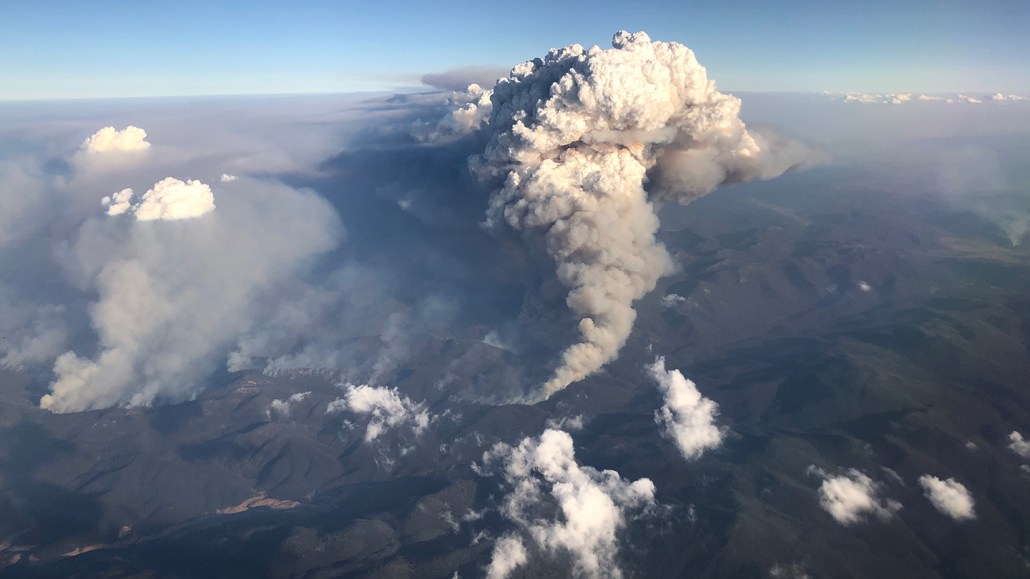How wildfires deplete the Earth’s ozone layer
Scientists detail the chain of chemical reactions that occur when smoke enters the stratosphere

In Australia’s summer of 2019 to 2020, wildfires produced towering columns of smoke (shown) that ascended into the stratosphere and reacted with Earth’s ozone layer.
DLMcK/E+/Getty images
- More than 2 years ago
Towering clouds of smoke sent into the stratosphere by ferocious wildfires can eat away at Earth’s ozone layer thanks to a potent mix of smoke, atmospheric chemistry and ultraviolet light, a new study finds.
During late 2019 and early 2020, Australia’s skies turned black, darkened by thick columns of wildfire smoke that reached into the stratosphere. In the aftermath, satellite data revealed that the smoke was somehow reacting with atmospheric molecules to eat away at Earth’s ozone layer (SN: 3/17/22). But how exactly that was happening wasn’t clear.
Now, scientists have put together the pieces of that chemical puzzle. Once in the stratosphere, the team says, the smoke particles were able to interact with stratospheric gases as well as lingering emissions of ozone-destroying chemicals. Add in solar radiation, and that smoky brew churned out chlorine radicals, a type of chemical with an affinity for attacking ozone, researchers report in the March 9 Nature.
This series of events was responsible for depleting about 3 to 5 percent of the ozone layer in parts of the Southern Hemisphere during 2020, the researchers estimate. That’s a small fraction of the whole — but it rivals the scale of the impact of human emissions of ozone-eating chlorofluorocarbons in their heyday, says MIT atmospheric chemist Susan Solomon.
Chlorofluorocarbons were once used in air conditioners and refrigerators, but their emission to the atmosphere led to a large hole over Antarctica in Earth’s protective ozone layer, which limits how much of the sun’s ultraviolet radiation reaches the planet’s surface.
In the new study, Solomon and her colleagues compared atmospheric observations of chlorine, ozone and other molecules following the Australian wildfires with simulations of atmospheric chemistry. Satellites had measured the abundance of certain chemicals in the stratosphere in 2020 — not just ozone, but also hydrogen chloride gas and chlorine nitrate, among others. Those levels caught Solomon’s attention.
“What we saw over Australia was a tremendous drop in hydrogen chloride” in the satellite data, Solomon says. “I thought, gosh, this looks just like Antarctica. How can this be happening over Australia?”
Hydrogen chloride gas is a product of the breakdown of chlorofluorocarbons, which can linger for decades in the stratosphere. The frigid environment over Antarctica was a key part of the ozone hole’s formation, because at those temperatures hydrogen chloride gas can dissolve into the icy clouds traveling through the stratosphere. The absorption of that gas is essential to starting the chain of reactions that form ozone-depleting chemicals.
The atmosphere over Australia is too warm for this process — but the satellite data indicated that something was still removing hydrogen chloride gas from the atmosphere. Solomon and her team realized that the culprit was the organic particles in the smoke. Those particles can absorb hydrogen chloride gas even at warmer temperatures, kicking off that essential first step.
With the absorbed hydrogen chloride, the smoke particles can act as catalysts, helping to speed along other reactions in the atmosphere. In particular, the particles amp up the transformation of other chlorine-containing gases floating in the stratosphere, such as chlorine nitrate and hypochlorous acid, into chlorine compounds that are highly reactive to sunlight.
Mixing the sun’s ultraviolet radiation with those new chlorine compounds produces chlorine radicals, freewheeling molecules that are extremely chemically reactive — and especially enjoy attacking ozone molecules.
The discovery of this wildfire-related process for destroying ozone is a worrisome potential setback to the recovery of the ozone layer, Solomon says. The 1987 Montreal Protocol targeted the use of chlorofluorocarbons, which were phased out by 2010, an act that has been encouragingly successful at shrinking the hole in the ozone over Antarctica (SN: 2/10/21). The ozone layer has shown signs of recovery ever since, growing back on the order of 1 percent per decade, she says.
However, the smoke from the Australian wildfires more or less “wiped out all that hard work” for the year, Solomon adds.
Climate change is expected to increase the intensity and frequency of wildfires around the globe, sending more towering fire clouds high into the sky (SN: 12/15/20). If these fires “are a one-time deal, it’s maybe not so bad” for ozone recovery, Solomon says. “But if it happens every five years, that’s a different kettle of fish.”
The study elegantly explains several puzzling satellite observations made in the wake of the Australian fires, says Ross Salawitch, an atmospheric chemist at the University of Maryland in College Park who was not involved in the work. It elucidates the drop in hydrogen chloride, he says, as well as strange increases in other chlorine compounds like chlorine nitrate and chlorine oxide.
But the “icing on the cake,” Salawitch says, is how the discovery of the role of organic particles can improve our understanding of what controls the size of the ozone hole. This is important, not just because we want to get the details right, he says, but because “one of the unfortunate consequences of global warming is likely an increase in the frequency and severity of wildfires.”






